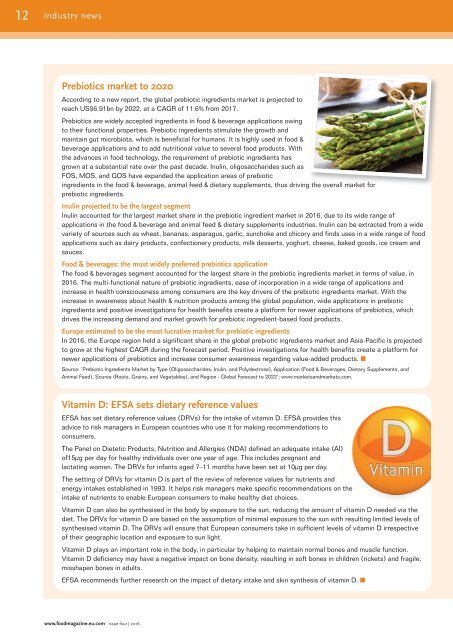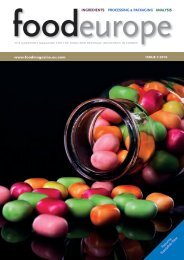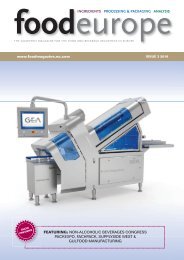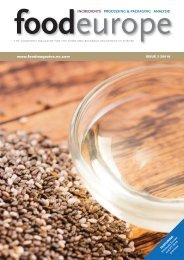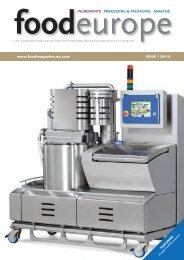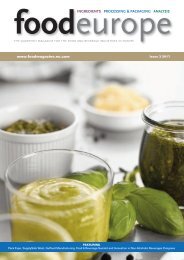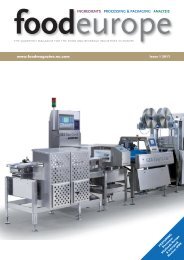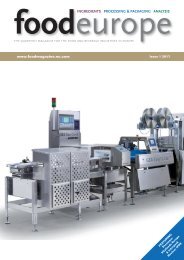FoodEurope Issue 4 2016
Create successful ePaper yourself
Turn your PDF publications into a flip-book with our unique Google optimized e-Paper software.
12 industry news<br />
Prebiotics market to 2020<br />
According to a new report, the global prebiotic ingredients market is projected to<br />
reach US$6.91bn by 2022, at a CAGR of 11.6% from 2017.<br />
Prebiotics are widely accepted ingredients in food & beverage applications owing<br />
to their functional properties. Prebiotic ingredients stimulate the growth and<br />
maintain gut microbiota, which is beneficial for humans. It is highly used in food &<br />
beverage applications and to add nutritional value to several food products. With<br />
the advances in food technology, the requirement of prebiotic ingredients has<br />
grown at a substantial rate over the past decade. Inulin, oligosaccharides such as<br />
FOS, MOS, and GOS have expanded the application areas of prebiotic<br />
ingredients in the food & beverage, animal feed & dietary supplements, thus driving the overall market for<br />
prebiotic ingredients.<br />
Inulin projected to be the largest segment<br />
Inulin accounted for the largest market share in the prebiotic ingredient market in <strong>2016</strong>, due to its wide range of<br />
applications in the food & beverage and animal feed & dietary supplements industries. Inulin can be extracted from a wide<br />
variety of sources such as wheat, bananas, asparagus, garlic, sunchoke and chicory and finds uses in a wide range of food<br />
applications such as dairy products, confectionery products, milk desserts, yoghurt, cheese, baked goods, ice cream and<br />
sauces.<br />
Food & beverages: the most widely preferred prebiotics application<br />
The food & beverages segment accounted for the largest share in the prebiotic ingredients market in terms of value, in<br />
<strong>2016</strong>. The multi-functional nature of prebiotic ingredients, ease of incorporation in a wide range of applications and<br />
increase in health consciousness among consumers are the key drivers of the prebiotic ingredients market. With the<br />
increase in awareness about health & nutrition products among the global population, wide applications in prebiotic<br />
ingredients and positive investigations for health benefits create a platform for newer applications of prebiotics, which<br />
drives the increasing demand and market growth for prebiotic ingredient-based food products.<br />
Europe estimated to be the most lucrative market for prebiotic ingredients<br />
In <strong>2016</strong>, the Europe region held a significant share in the global prebiotic ingredients market and Asia-Pacific is projected<br />
to grow at the highest CAGR during the forecast period. Positive investigations for health benefits create a platform for<br />
newer applications of prebiotics and increase consumer awareness regarding value-added products. n<br />
Source: ‘Prebiotic Ingredients Market by Type (Oligosaccharides, Inulin, and Polydextrose), Application (Food & Beverages, Dietary Supplements, and<br />
Animal Feed), Source (Roots, Grains, and Vegetables), and Region - Global Forecast to 2022’; www.marketsandmarkets.com.<br />
Vitamin D: EFSA sets dietary reference values<br />
EFSA has set dietary reference values (DRVs) for the intake of vitamin D. EFSA provides this<br />
advice to risk managers in European countries who use it for making recommendations to<br />
consumers.<br />
The Panel on Dietetic Products, Nutrition and Allergies (NDA) defined an adequate intake (AI)<br />
of15µg per day for healthy individuals over one year of age. This includes pregnant and<br />
lactating women. The DRVs for infants aged 7–11 months have been set at 10µg per day.<br />
The setting of DRVs for vitamin D is part of the review of reference values for nutrients and<br />
energy intakes established in 1993. It helps risk managers make specific recommendations on the<br />
intake of nutrients to enable European consumers to make healthy diet choices.<br />
Vitamin D can also be synthesised in the body by exposure to the sun, reducing the amount of vitamin D needed via the<br />
diet. The DRVs for vitamin D are based on the assumption of minimal exposure to the sun with resulting limited levels of<br />
synthesised vitamin D. The DRVs will ensure that European consumers take in sufficient levels of vitamin D irrespective<br />
of their geographic location and exposure to sun light.<br />
Vitamin D plays an important role in the body, in particular by helping to maintain normal bones and muscle function.<br />
Vitamin D deficiency may have a negative impact on bone density, resulting in soft bones in children (rickets) and fragile,<br />
misshapen bones in adults.<br />
EFSA recommends further research on the impact of dietary intake and skin synthesis of vitamin D. n<br />
www.foodmagazine.eu.com issue four | <strong>2016</strong>


